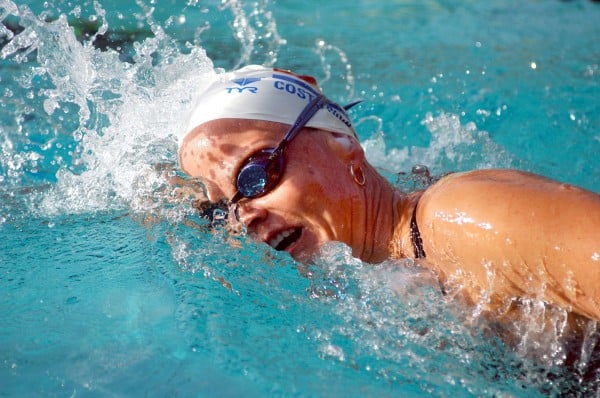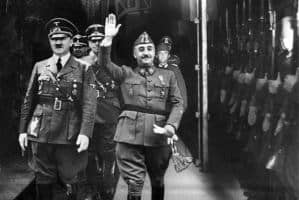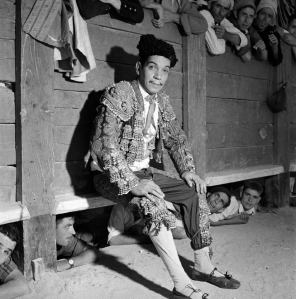
A camera is a time machine. You snap a picture – you freeze a living moment – and then you enable yourself to return to that moment for as long as the photograph exists. Unlike movies or video, a photo is efficient and compact. It is coldly precise in a way that paintings are not. The YouTube generation can’t usurp the power of still pictures, because a good photograph hits you like a hammer. It can tell the story of an entire era. For millions of people, Dorothea Lange’s “Migrant Mother” is the Great Depression. One leaf of glossy paper can recall entire chapters of human history.
That is why “EFE: 75 Years in Photos” is so irresistible: To browse this temporary exhibit at the National Museum is to journey through decades. Agencia EFE is a Spanish media company and the fourth-largest wire service in the world. Like the Associated Press and Reuters, EFE supplies countless world newspapers with photos and articles. The company employs more than 3,000 correspondents in 120 countries, and it floods the Spanish-speaking world with content. The few dozen portraits and landscapes in the “EFE” exhibit are some of their best and most significant.

The series is interesting because it takes familiar topics and shoots them from a different angle – literally. If you grew up with The New York Times, or Life or National Geographic magazines, you know the usual lineup of famous photographs: Steve McCurry’s “Afghan Girl” and Kevin Carter’s Sudanese child are so famous as to be clichés. But in the “EFE” exhibit, you will see the Twin Towers burning from a different street. You will see Adolf Hitler striding down a walkway with Francisco Franco. You will see an image of Río de Janeiro that features no Christ statue. The reference points are familiar, but the representations are new.
What’s strange about Agencia EFE is that the institution was founded in 1939 as the media wing of Franco’s fascist dictatorship. This isn’t as shocking as it seems: “Pravda” is still a functional Russian newspaper, and Walt Disney used to film racist propaganda films. Most large media companies have weathered regrettable eras, and Franco ruled Spain for nearly 40 years. But EFE has gone to great lengths to redeem itself. The company is deeply embedded in Latin America, it is an active member of the Inter American Press Association, and it hosts the King of Spain Awards for excellence in journalism – a kind of Pulitzer for pan-Iberian reporters. EFE has become a platform for Spanish-speaking intellectuals, who have been able to publically discuss major issues since the late 1970s.

The quality of photojournalism is famously difficult to judge, and sometimes a photographer creates an iconic image because of pure dumb luck. Some photos in the “EFE” exhibit are aesthetically striking: Three workers in hardhats stand by the large windows of a skyscraper as a city sprawls 1,000 ft. below. Other portraits are significant because of whom they depict: Gabriel García Márquez smiles happily, Costa Rican astronaut Franklin Chang poses with a shuttle crew, and the Mexican actor Cantinflas wears a matador’s outfit on a movie set. They are not great pictures, but they document those faces, keeping them alive for future generations.
One of the most surprising photos is a portrait of several jovial men sitting around a bullfighting ring. In the center leans a bearded man with a cigar, and you’d be forgiven to thinking he’s Fidel Castro (he’s not). But sitting off-center is Che Guevara, who is grinning raffishly beneath his beret. We are so accustomed to seeing Guevara in the photo “Guerrillero Heroico,” the face that launched a billion college T-shirts. That version of Guevara, intense and staring toward the horizon, his hair greasy and feral, his leathery jacket sipped to the Adam’s apple, is the one everybody knows. This photo is our default; when most people think of Che Guevara, they immediately conjure this portrait in their minds. This is the danger that photographs run, the danger Susan Sontag warned about in her seminal (and hostile) book “On Photography”: “Today everything exists to end in a photograph.”
Instead, we see Guevara hanging out at a stadium, looking boyish and carefree, as if he can’t wait to tell the man next to him a hilarious joke. The power of a photograph is that it can preserve a memory. The power of two photographs is that they preserve a memory in two distinct ways, and while neither one tells the whole story, we can guess that reality was somewhere in between.
“EFE: 75 Años en Fotos” continues through Dec. 7 at the National Museum, downtown San José. Tue.-Sat., 8:30 a.m. – 4:30 p.m.; Sun., 9 a.m. – 4:30 p.m. ₡4,000 ($8). Info: National Museum website.





